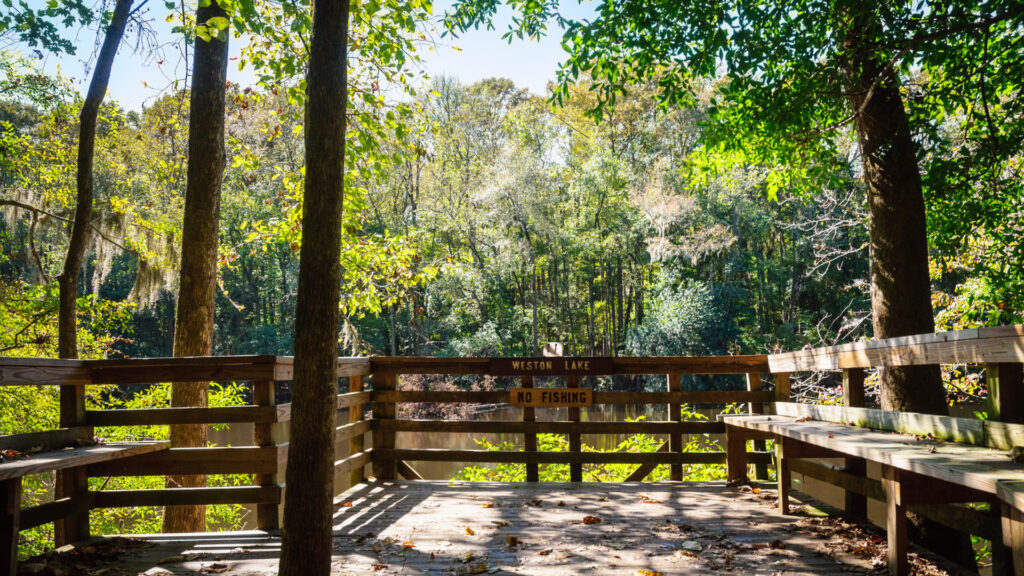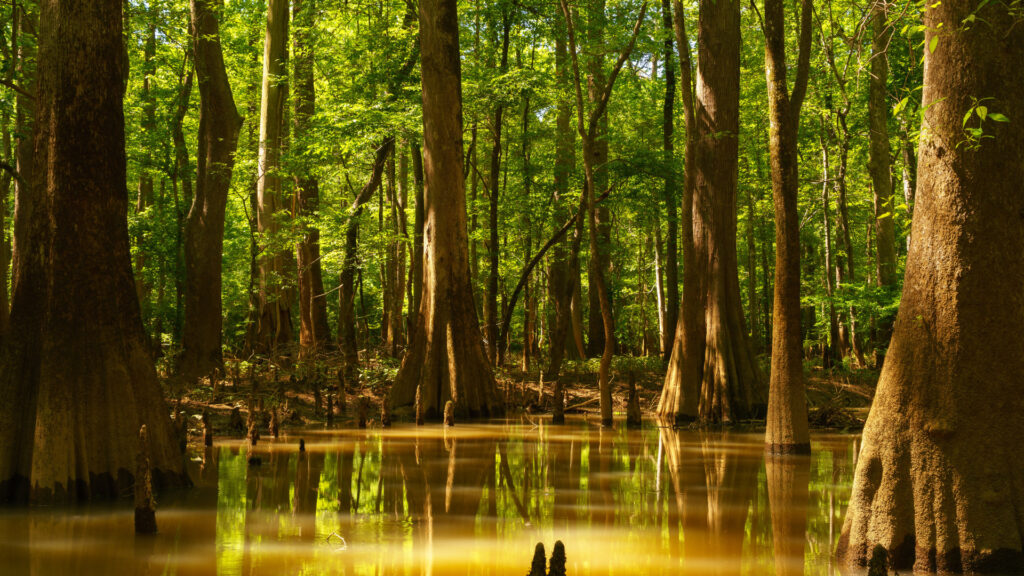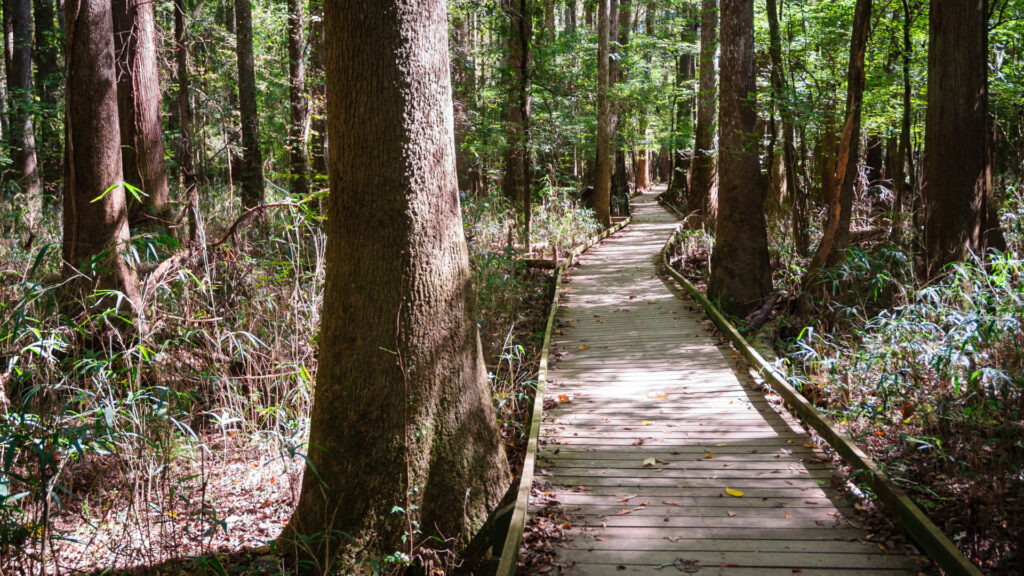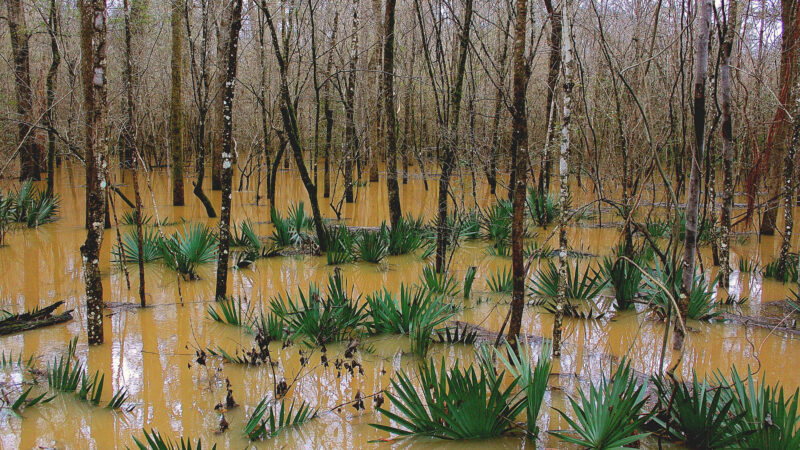Table of Contents Show
When you plan to visit a National Park, you expect to see grand vistas. Perhaps you’ll imagine towering mountain ranges in the Rocky Mountains or deep canyons that extend farther than the eye can see in Canyonlands.
You can’t wait to see the crashing waves against the rocky shoreline of Acadia or experience epic wildlife adventures in the Everglades.
But what about Congaree National Park? What’s there to see that’s glorious, breathtaking, or inspiring?
We’ll examine why this South Carolina park is the ugliest National Park in the country. Let’s get started!
About Congaree National Park
Congaree National Park is truly a wilderness. According to the National Park Service, “The largest intact expanse of old growth bottomland hardwood forest remaining in the southeastern United States” exists here in Hopkins, South Carolina.
It has over 26,000 acres of federally-protected land. Visitors can experience this wilderness on foot via hiking trails or a canoe or kayak via the Cedar Creek or Congaree River. Tent camping, birding, and fishing are also popular here.
The government established Congaree Swamp National Monument 18 miles from Columbia in 1976 to protect the floodplain. In 2003, they redesignated the park to Congaree National Park.
In addition to being a National Park, the area is a designated wilderness area, a UNESCO biosphere reserve, an important bird area, and a national natural landmark.
Where Is Congaree National Park?
Congaree National Park is east of Highway 601 and west of Interstate 26 in Hopkins, South Carolina.
Although it’s only a 30-minute drive from Columbia, it seems far removed from the big city atmosphere of the state’s capital.
It’s northwest of Lake Marion, the largest lake in South Carolina with 315 miles of shoreline. Manchester State Forest is directly east of the National Park.
Is Congaree National Park a Swamp?
Initially, Congaree Swamp National Monument, the federal government removed the “swamp” from the name when redesigning it as a National Park.
The land is bottomland, subject to flooding, and not a swamp. Designated in an old-growth forest, it contains the tallest examples of 15 tree species.
These include 167-foot 361-point loblolly pine, 157-foot 384-point sweetgum, a 154-foot 465-point cherrybark oak, and a 127-foot 219-point common persimmon.
These may not compare to the 300-foot Redwoods in California, but these trees aren’t among the tallest in the world.

Why Is Congaree National Park Ugly?
There’s a reason Congaree National Park is the tenth least-visited National Park in the country.
It’s not because it’s remote, like Isle Royale or Dry Tortugas. The reason is not because it’s so far away, like Denali or Gates of the Arctic. It’s because it’s simply ugly.
It’s Basically a Swamp
Even though people might not call it a swamp anymore, Congaree National Park is basically like a swamp.
If a swamp is a forested wetland, this acreage meets that definition. It’s not continually underwater like a marsh, but the soil is saturated, and trees dominate the landscape.
This doesn’t compare to the cacti of Saguaro or the pristine water of Crater Lake.

Mosquitos Will Eat You Alive
If you’re familiar with the Southeast, you know the mosquitos are alive and well. Because of the swampy landscape, there is ample stagnant water where mosquitoes can lay their eggs.
Congaree National Park is a breeding ground for these pesky insects. It’s not the same as seeing roaming bison in Yellowstone or black bears in Shenandoah.
Keep in Mind: Keep mosquitos away with one of these options to help avoid mosquitoes bites!
Snakes and Poison Ivy
Like the mosquitos, snakes love the wetland of Congaree National Park. Eastern rat snakes are the most common in the area.
Although they are non-venomous, you should still keep your distance. The water moccasin (or cottonmouth), copperhead, and canebrake rattlesnake are three venomous snakes you want to watch in the park.
Poison ivy also grows here as ivy or shrubs. This plant’s growth is expanding in abundance, size, and density.
This is due in part to global warming and increased CO2 gasses. Should you contact their skin-irritating oils, you’ll be uncomfortable during the rest of your visit.
Poorly Marked and Washed Out Trails
After almost 58 hours of wandering in the National Park, J.R. Kimbler and his two kids finally found a rescue team. What happened?
They were hiking on the boardwalk trail and followed a sign for fishing when they got lost and couldn’t find the path again.
The trails in Congaree National Park can be poorly marked, and when you find a track you can follow, you’re lucky if it’s not washed out. If you want to go hiking, this National Park isn’t the best choice.

Things to Do at Congaree National Park
If you still visit Hopkins, South Carolina, there are a few activities you can enjoy.
Remember, hiking and camping may lead to snake encounters. Paddling and fishing may mean never-ending bites from mosquitoes.
Hiking
Six of the eleven hiking trails are easy and appropriate for all skill levels. The Fork Swamp Trail, the Kingsnake Trail, and the Weston Lake Trail are moderate because they are difficult to follow, subject to flooding, and more strenuous.
The Oakridge Trail and the River Trail are difficult trails due to their lengths; 7.1 miles and 11.1 miles, respectively. Officials urge hikers to use caution as storms consistently knock down trees, and the trails are challenging to follow.

Canoeing/Kayaking
Cedar Creek can be below the ideal water level for paddling, so paddlers should be ready to encounter numerous obstacles in the creek.
The canoe trail is marked, but these markers may or may not be visible because of the water levels. Poison ivy, wasps, mosquitos, and snakes are common along the creek and the Congaree River.
Fishing
If you plan to fish in Congaree National Park, you must have a valid South Carolina fishing license.
They prohibit motor boats but allow fishing in the park if you stand at least 25 feet from any artificial structure, including bridges, boardwalks, and overlooks. You cannot use minnows, amphibians, or fish eggs as bait.
Camping
You must have a reservation to camp in Congaree National Park. No RV sites exist, and you cannot drive to the campsites. Tent campers and backpackers must park and walk to their campsites.
The sites in the Longleaf Campground are about 100 yards from the parking lot. The camping areas in the Bluff Campground are approximately one mile from the parking lot.
Backcountry camping is complimentary, while overnight stays in either campground will cost $5-10 per night.
Pro Tip: These National Parks will take your breathe away! These are the best ranked National Parks in the USA
Ranger-Led Programs
When visiting any National Park, always examine the calendar of events to find scheduled ranger-led programs. In Congaree National park, you can participate in yoga, art activities, and more.
The Junior Ranger program allows the youngest visitors to learn more about the park, its ecosystems, and wildlife, and they can earn badges to take home.
Is Congaree National Park Worth Visiting?
Although Congaree National Park may be the ugliest National Park in the country, it is still worth visiting to learn more about wetlands and woodlands.
There is much history here. The highest temperate deciduous forest canopies in the world are in Congaree National Park.
However, if you’re looking for a week of family fun, there are better National Parks to visit first.
Even if you can’t leave the East Coast, drive a few hours to the most-visited National Park, the Great Smoky Mountains. You can enjoy miles of hiking trails and beautiful scenic views while learning about the Cherokee people.
So is Congaree National Park worth visiting? That’s up to you to decide.






